Z-Path
- Introducing the Z boson
- Introducing the Higgs boson
-
Identifying particles
- ATLAS detector
- Play!
- Visualization with HYPATIA
- Particle footprint visualization
- Practice!
- Identifying Events
- Search and discover with mass
- Get to work!
Knowledge Center
Identifying particles
In order to analyze the proton-proton collisions that HYPATIA displays, you need to know how you can identify particles and distinguish various particle types in the detector. In this section you will learn how to identify electrons (as well as positrons), muons (and anti-muons), photons, neutrinos, and other more complicated particles – hadrons like the proton - that are often produced in form of “ jets”.
Click on the icons to learn about the identification of electrons, muons, photons, neutrinos and jets.
-
 This signature is generated by an electron. The particle has left a track (red) in the inner detector (therefore it carries electric charge) and has released all its energy within the electromagnetic calorimeter since it is the only one in which you can find deposits. This can be seen from the yellow little boxes inside the light-green structures that represent the electromagnetic calorimeter. Since there are neither entries in the hadronic calorimeter nor the muon chamber it is an electron or positron.
This signature is generated by an electron. The particle has left a track (red) in the inner detector (therefore it carries electric charge) and has released all its energy within the electromagnetic calorimeter since it is the only one in which you can find deposits. This can be seen from the yellow little boxes inside the light-green structures that represent the electromagnetic calorimeter. Since there are neither entries in the hadronic calorimeter nor the muon chamber it is an electron or positron.
-
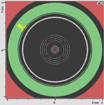 The same event in the end view. The track through all three inner detectors and the yellow little boxes of the deposits in the electromagnetic calorimeter can be easily recognised.
The same event in the end view. The track through all three inner detectors and the yellow little boxes of the deposits in the electromagnetic calorimeter can be easily recognised.
-
 The side view shows the same. If you combine the side and end view you will get a spatial impression of the event. This is excellent training for your mind.
The side view shows the same. If you combine the side and end view you will get a spatial impression of the event. This is excellent training for your mind.
-
 How can you decide whether it is an electron or a positron? In the toolbar of HYPATIA you find a hand with a pointed forefinger. By clicking on this option you can chose a track of a particle in the event display (again by clicking on it). You will then see information in the lower-right window. This information contains, for example, measured values of space-dependent components of the momentum (Px, Py, Pz) and the transverse momentum (PT). In the following picture you see the information of this window.
How can you decide whether it is an electron or a positron? In the toolbar of HYPATIA you find a hand with a pointed forefinger. By clicking on this option you can chose a track of a particle in the event display (again by clicking on it). You will then see information in the lower-right window. This information contains, for example, measured values of space-dependent components of the momentum (Px, Py, Pz) and the transverse momentum (PT). In the following picture you see the information of this window.
-
 The sign of the PT-value (here a minus) shows you the nature of the electric charge of the particle belonging to the track. A negative sign means that the particle is negatively charged. No sign (or a positive sign) means that the particle is electric positively charged. Now we can see that it is an electron in our event.
The sign of the PT-value (here a minus) shows you the nature of the electric charge of the particle belonging to the track. A negative sign means that the particle is negatively charged. No sign (or a positive sign) means that the particle is electric positively charged. Now we can see that it is an electron in our event.
-
 In this event display one sees a track (orange) in the inner detector, small energy depositions in the electromagnetic as well as in the hadronic calorimeter (both displayed by yellow little boxes inside the light-green and red structures), and in the muon chambers (orange). It is a muon (or an anti-muon) which is the only particle that goes through the whole detector and thereby leaves signals in all shells.
In this event display one sees a track (orange) in the inner detector, small energy depositions in the electromagnetic as well as in the hadronic calorimeter (both displayed by yellow little boxes inside the light-green and red structures), and in the muon chambers (orange). It is a muon (or an anti-muon) which is the only particle that goes through the whole detector and thereby leaves signals in all shells.
-
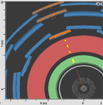 In this enlarged view, you can see the orange entries in the muon chambers very clearly.
In this enlarged view, you can see the orange entries in the muon chambers very clearly.
-
 In side view, the individual entries in the muon chambers are represented as orange crosses. All of these crosses are connected by an orange dotted line which symbolizes the track of the particle.
In side view, the individual entries in the muon chambers are represented as orange crosses. All of these crosses are connected by an orange dotted line which symbolizes the track of the particle.
-
 Muon or anti-muon? The same procedure that we described with the electron/positron provides the result: In this event display, a muon is pictured (negative sign).
Muon or anti-muon? The same procedure that we described with the electron/positron provides the result: In this event display, a muon is pictured (negative sign).
-
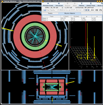 In this event there are a lot of tracks (blue lines) in the Inner Detector. There is some energy deposited in the electromagnetic calorimeter indicated by the yellow boxes inside the light-green structures (electromagnetic calorimeter). If you select the "Physics Objects" tab you can see that there are two reconstructed objects, visible as two yellow towers in the event-view. It's hard to see if this event contains two electrons or two photons so further investigation is required.
In this event there are a lot of tracks (blue lines) in the Inner Detector. There is some energy deposited in the electromagnetic calorimeter indicated by the yellow boxes inside the light-green structures (electromagnetic calorimeter). If you select the "Physics Objects" tab you can see that there are two reconstructed objects, visible as two yellow towers in the event-view. It's hard to see if this event contains two electrons or two photons so further investigation is required.
-
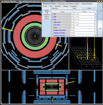 By requiring the pT of the tracks to be > 5 GeV most of the tracks disappear. The only track, which is left is not pointing towards any of the yellow towers. Since there are no high pT tracks, this is probably not an electron or positron. We have still a lot of energy in the electromagnetic calorimeter, so this must be a di-photon event.
By requiring the pT of the tracks to be > 5 GeV most of the tracks disappear. The only track, which is left is not pointing towards any of the yellow towers. Since there are no high pT tracks, this is probably not an electron or positron. We have still a lot of energy in the electromagnetic calorimeter, so this must be a di-photon event.
-
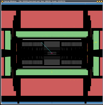 By zooming in on the side-view you can see the clustering of yellow boxes in the electromagnetic calorimeter (upper right and down in the middle). Again, no tracks are pointing towards the clusters.
By looking at the "Physics Objects" tab you can see two reconstructed objects. Since we from the previous pictures know that these can't be electrons or positrons they are probably photons. We can then click on the Objects and select them as photons.
By zooming in on the side-view you can see the clustering of yellow boxes in the electromagnetic calorimeter (upper right and down in the middle). Again, no tracks are pointing towards the clusters.
By looking at the "Physics Objects" tab you can see two reconstructed objects. Since we from the previous pictures know that these can't be electrons or positrons they are probably photons. We can then click on the Objects and select them as photons.
-
 How does one recognize a neutrino? Neutrinos don't interact with even a single component of the ATLAS-detector. They neither interact with the tracking detector, nor the calorimeters, nor the muon chambers. How can one therefore detect something which we cannot see? Since all quarks and gluons move along the beam axis before the proton-proton collision all of their velocity components at right angles to the beam (perpendicular) and therefore the so called transverse total momentum is zero. Due to momentum conservation the transverse total momentum (the vectorial sum of the transverse momentum of all particles) has to be zero after the collision as well. If the measurements contradict this, either particles that are invisible to the detector are produced (e.g. one or more neutrinos which have got exactly this missing transverse momentum) or particles carrying tranverse momentum leave ATLAS without beeing detected or ATLAS do not certainly measure.
How does one recognize a neutrino? Neutrinos don't interact with even a single component of the ATLAS-detector. They neither interact with the tracking detector, nor the calorimeters, nor the muon chambers. How can one therefore detect something which we cannot see? Since all quarks and gluons move along the beam axis before the proton-proton collision all of their velocity components at right angles to the beam (perpendicular) and therefore the so called transverse total momentum is zero. Due to momentum conservation the transverse total momentum (the vectorial sum of the transverse momentum of all particles) has to be zero after the collision as well. If the measurements contradict this, either particles that are invisible to the detector are produced (e.g. one or more neutrinos which have got exactly this missing transverse momentum) or particles carrying tranverse momentum leave ATLAS without beeing detected or ATLAS do not certainly measure.
-
 In the ATLAS-Detector, the missing transverse momentum is determined by the energy deposited in the calorimeters. When there is an imbalance within this energy distribution – which is called missing transverse energy (Missing ET) – this suggests a neutrino which was produced during the collision. There are two ways that this is shown with HYPATIA: 1. By the Missing ET-value in the upper right event display that has a grey frame, and 2. by the red dashed line in end view. This line makes the direction of the energy imbalance clear on the one side. On the other side is the thickness of this line a measure for the value of the missing transverse energy.
In the ATLAS-Detector, the missing transverse momentum is determined by the energy deposited in the calorimeters. When there is an imbalance within this energy distribution – which is called missing transverse energy (Missing ET) – this suggests a neutrino which was produced during the collision. There are two ways that this is shown with HYPATIA: 1. By the Missing ET-value in the upper right event display that has a grey frame, and 2. by the red dashed line in end view. This line makes the direction of the energy imbalance clear on the one side. On the other side is the thickness of this line a measure for the value of the missing transverse energy.
-
 In this event, an electron and neutrino were produced nearly exclusively. Since these two particles are kind of the only ones that have been produced the transverse total momentum is split between these two because of conservation of momentum. That is why the neutrino with its share of the transverse momentum flies away from the electron in the nearly opposite direction. The related missing energy is determined with the help of the event display and plotted in the direction of its transverse momentum. A thick dashed red line therefore always indicates the existence of one or more invisible particles, e.g. neutrinos. Smaller missing transverse momentums of about 10-20 GeV (thin red dashed lines) can also be caused by measurement uncertainties of the detector.
In this event, an electron and neutrino were produced nearly exclusively. Since these two particles are kind of the only ones that have been produced the transverse total momentum is split between these two because of conservation of momentum. That is why the neutrino with its share of the transverse momentum flies away from the electron in the nearly opposite direction. The related missing energy is determined with the help of the event display and plotted in the direction of its transverse momentum. A thick dashed red line therefore always indicates the existence of one or more invisible particles, e.g. neutrinos. Smaller missing transverse momentums of about 10-20 GeV (thin red dashed lines) can also be caused by measurement uncertainties of the detector.
-
 In this event display so called jets are shown. Each jet consists of a bundle of several particles. The electric charged particles cause tracks in the inner detector whereas the neutral ones don't. If you extrapolate the tracks you will find many entries in the calorimeters. Other depositions nearby cannot assign to a track because they were caused by electric neutral particles. Especially the hadronic calorimeter contains many entries. That is because every jet is the result of a gluon, quark, or antiquark that is ejected from the proton during the collision. Thereby big amounts of energy are at work in order to overcome the huge binding forces. A part of this energy is used to create new quark-antiquark pairs which move in nearly the same direction and bind each other to form new particles – so called hadrons. These generate the shown jets that have a grey background in this picture in order to recognise it more easily.
In this event display so called jets are shown. Each jet consists of a bundle of several particles. The electric charged particles cause tracks in the inner detector whereas the neutral ones don't. If you extrapolate the tracks you will find many entries in the calorimeters. Other depositions nearby cannot assign to a track because they were caused by electric neutral particles. Especially the hadronic calorimeter contains many entries. That is because every jet is the result of a gluon, quark, or antiquark that is ejected from the proton during the collision. Thereby big amounts of energy are at work in order to overcome the huge binding forces. A part of this energy is used to create new quark-antiquark pairs which move in nearly the same direction and bind each other to form new particles – so called hadrons. These generate the shown jets that have a grey background in this picture in order to recognise it more easily.
-
 Keep in mind: Particles that fan out, cause tracks in the inner detector and have entries in the electromagnetic and especially the hadronic calorimeter can be put down to quarks, antiquarks, and gluon, and are called jets.
Keep in mind: Particles that fan out, cause tracks in the inner detector and have entries in the electromagnetic and especially the hadronic calorimeter can be put down to quarks, antiquarks, and gluon, and are called jets.




